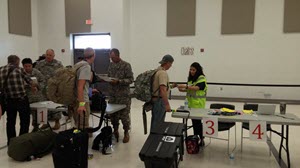Story by: Spc. Stefan Wray, Spc. Matthew Bramanti, and Sgt. Greg Illich, Texas State Guard
Posted: June 17, 2016
 HARLINGEN, Texas - The Texas State Guard is ready this hurricane season. In a major training exercise, over 300 guardsmen from each component of the State Guard learned firsthand how to conduct a massive hurricane evacuation during a large-scale training exercise in the Rio Grande Valley, June 6 - 9, 2016.
HARLINGEN, Texas - The Texas State Guard is ready this hurricane season. In a major training exercise, over 300 guardsmen from each component of the State Guard learned firsthand how to conduct a massive hurricane evacuation during a large-scale training exercise in the Rio Grande Valley, June 6 - 9, 2016.
"This exercise was a tremendous training and coordination opportunity among the Texas Military Department and emergency management agencies," said Texas State Guard Brig. Gen. Howard N. Palmer, Jr., commander, Army Component Command. "When a significant event occurs, the Texas State Guard will apply the lessons learned at this exercise and will be fully prepared for deployment to assist and support the citizens of Texas."
The Texas Division of Emergency Management and the Texas Military Department Domestic Operations Task Force planned this exercise to test the ability and readiness to evacuate persons by bus and aircraft out of the Rio Grande Valley in the event of a hurricane strike.
Working with service members and employees from the Texas Army National Guard, Texas Air National Guard, Texas State Guard, multiple local and state emergency agencies and the American Red Cross, state emergency management tested the use of aircraft as a mode of evacuation of medical evacuees for the first time, while also providing medical attention and sheltering operations to mock hurricane victims.
The Federal Emergency Management Agency estimates that in a major hurricane emergency 30,000 civilians would need to be evacuated from The Valley, making the ability to evacuate and track thousands of people efficiently and effectively is important to emergency management operations.
State Guard participation in the exercise and in a real-world state emergency is invaluable, said Lee Schnell, a section administrator for the Texas Division of Emergency Management. "Without the State Guard, this doesn't happen."
Texas State Guardsmen supported several areas of the exercise, including emergency tracking trainers, Texas Operations Center members, command and control members, medical observers, mock evacuees and search-and-rescue victims.
The first phase of the four-day operation was the movement of the soldiers to various locations around the state. Using this as an opportunity to train, Guardsmen followed standard military operation procedures throughout the transportation process, practicing communication networking with partner agencies along the route.
Upon arrival in Harlingen, the soldiers checked-in through a new in-process and out-process system rolled out for the first time by the Texas Military Department.
Right away, soldiers trained on the Texas Emergency Tracking Network, a tool Texas State Guardsmen often use to support sheltering operations following large-scale evacuations, According to the Texas Department of Public Safety, this tracking system allows the state operations center to in-process every evacuee, keep track of evacuees as they are transported to shelters in other parts of the state, and track medical assets.
It also helps to reunite family members, comforts evacuees that their loved ones are safe, and saves lives. Even evacuated pets are tracked by the system so that pet owners can also be reunited with their pets.
"The new evacuation tracking system that we are training on is very intuitive,” said Texas State Guard Staff Sgt. Cheryl Lemmings, 1st Battalion, 8th Regiment. “It's a good feeling to know that we are preparing to help others in a time of crisis."
After a day of training, many of the guardsmen switched gears and participated in the medical evacuation exercise role playing evacuees.
They received wrist bands and were in-processed through the emergency tracking network just as evacuees would be in a real evacuation, many also receiving medical treatment from Texas Army and Air National Guardsmen for mock injuries. Following check in, they boarded busses for the Valley International Airport in Harlingen and went through the Transportation Security Administration security checks before taking Texas Air National Guard C-130 flights back to Dallas, Houston, Austin and San Antonio.
"This is a true joint exercise with all the different agencies working together," said Texas State Guard Staff Sgt. Mike Mills, 1st Battalion, 2nd Regiment. "It's great to see it from the evacuee's side and helps me to empathize with them. We will be able to take that back and learn from it."
Upon arriving at their respective airports, the role playing guardsmen were moved to designated shelters to spend the night just as evacuees would, away from the hurricane strike zone.
On the last day of the operation, June 9, 2016, soldiers returned to their home of record with a much greater understanding of what happens during an evacuation.
"The professionalism demonstrated by the men and women of the Texas State Guard in this Rio Grande Evacuation Exercise is a credit to all Texans, said Maj. Gen. Jake Betty commander of the Texas State Guard. “ It will be a foundation for future possible disaster missions."